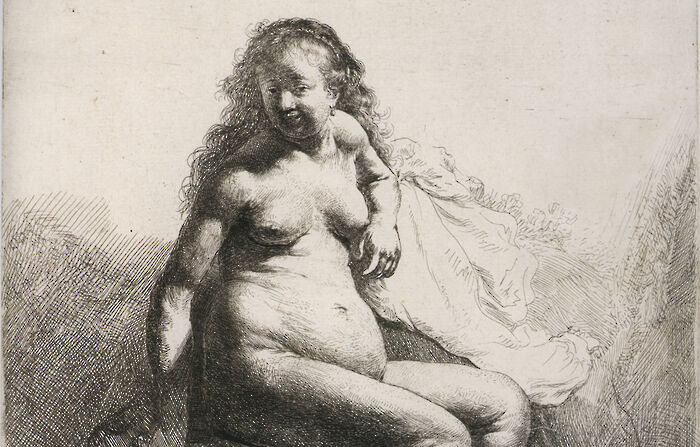Divided Circle frustrates the distinction between self and world
Reviewer Harry Goodwin sees in Barbara Hepworth’s sculptures the movements that underpin our physical existence

In the 1979 TV adaptation of Roald Dahl’s Tales of the Unexpected, there features a scene in which a character played by Joan Collins gets her head stuck in an abstract sculpture during adulterous horseplay, before being spontaneously beheaded by her spiteful husband. The farce speaks to the power of chiselled masses of wood and rock depicting nothing much at all to expose the baroque immaturity of one idiotic English male among many.
I was reminded of it when I encountered Two Spheres in Orbit, one of the late works by Barbara Hepworth currently exhibited under the title Divided Circle at the unfussy Heong Gallery. Confronted by this lovely pair of white marble orbs placed in perfect spatial harmony, I found myself wondering how big a shove it would take to knock one off its plinth, and how much it would hurt if it then landed on my foot. Childish though such preoccupations might be, they chime with the essence of Hepworth’s art. Her sculptures convey quite viscerally her fixation on the semi-conscious mental mathematics through which we control our embodied selves. In Disc with Strings (Moon), for example, taut strings physically depict the sort of instantaneous measurements we make whenever we catch a ball or shut a door.

The thing about such measurements is that few of us could translate them into ordered calculation on paper, and yet they underpin our physical existence. For Hepworth, this psychological paradox exposes the unity of the human subconscious with a broader cosmic clockwork, frustrating any rationalist distinction between self and world. Among the most beautiful works in Divided Circle are Hepworth’s small but palpably weighty studies in bronze and gold. Their littleness intimates a hostility to monumentality, the idea that stone and metal only acquire emotional resonance when bashed into supersized likeness of a Caesar or Buddha or Stalin. Seeing our chrome reflections in their shiny surfaces, we bridle at the thought that we, like them, are material forms bound by gravity.

It’s a humbling intuition inimical to the political and religious pomposities of monumentality. But it’s also a compelling one. The only way we can fully savour Two Rocks, a gorgeous study in Irish black marble, is by walking around it. Our mental urge to understand the physical interplay of balance and weight pulls us out of the contemplative stupor of simply regarding a piece and into the world. During her dotage Hepworth lived by the Atlantic at St Ives, forever attentive to the linked harmonies of sun, moon and sea. The screen prints and lithographs displayed alongside the sculptures in Divided Circle are pervaded by an elemental calmness flowing from the attendant sense of a serene harmony between man and the universe.
As one begins to tire of Hepworth’s monotone spaciness, it yields to personal emotion
Not that there aren’t duds here. Construction, a sterile, Christ-less rendition of the Crucifixion, exemplifies the watery dullness which arises when cosmic tranquility is substituted for human feeling, with Hepworth’s inclination towards abstraction here resulting in an unexciting combination of Etch-a-Sketch pencil lines over a smudgy blue-brown wash. I was left unengaged by the exhibition’s outdoor title piece, which consists of two drab hunks of bronze devoid of the precarious physicality which enlivens the other sculptures.
Yet as one begins to tire of Hepworth’s monotone spaciness, it yields to personal emotion. Forms in Movement (Galliard) is an altogether different kind of piece, consisting of pivoting curves of copper looping round each other. Hepworth’s life was marked by experience of maternal angst and grief in extremis, and I sensed an implosive energy in the rounded, womblike capaciousness of the space contained within the sculptural forms, as if no amount of mental mathematics can in the end take the measure of a mother’s love. It alone makes this exhibition worth your visit.
 News / Uni Scout and Guide Club affirms trans inclusion 12 December 2025
News / Uni Scout and Guide Club affirms trans inclusion 12 December 2025 News / Pembroke to convert listed office building into accom9 December 2025
News / Pembroke to convert listed office building into accom9 December 2025 News / Cambridge Vet School gets lifeline year to stay accredited28 November 2025
News / Cambridge Vet School gets lifeline year to stay accredited28 November 2025 Features / Searching for community in queer Cambridge10 December 2025
Features / Searching for community in queer Cambridge10 December 2025 News / Uni redundancy consultation ‘falls short of legal duties’, unions say6 December 2025
News / Uni redundancy consultation ‘falls short of legal duties’, unions say6 December 2025









